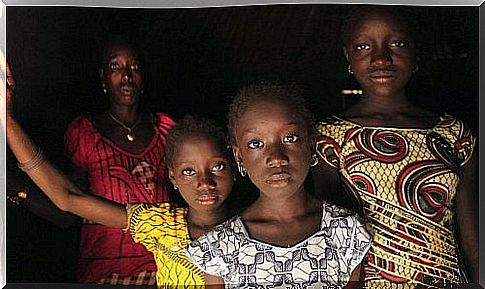Great News: Africa Says NO To Female Genital Mutilation

This is, without a doubt, the kind of news we love to share with our readers. Africa has said no to female genital mutilation.
The African Parliament reached an agreement to ban this ritual, tragic and discriminatory practice.
It was not long ago that we explained in our space that countries such as Nigeria had already taken the initiative to start regulating and pursuing this tradition.
Now, the grain of sand has grown larger and full of hope with broader support.
Finally, there is a common agreement in which the African Parliament, based in South Africa, is committed to regulating, pursuing and ending a drama that has marked nearly 200 million women around the world, according to UNICEF data.
We’ll give you all the details below.
Female Genital Mutilation, A Drama With Too Many Victims
Female genital mutilation is not unique to Africa. Clitoris extirpation is also present in practically all Muslim countries on the Asian continent.
Kurdish communities as well as Afghanistan, Tajikistan, Brunei, Malaysia and Indonesia also practice it. In these countries, the most radical type of mutilation is performed: infibulation, which consists of extirpation of the clitoris and the labia majora and minora.
We know this is a battle that has not yet been won. We also know that this great step taken in Africa is, at the moment, an agreement of intent that has yet to be formalized.
Because today we only have a proposal that has not yet become a law.
However, as we said, it is a big step towards a drama that has already claimed too many victims.

It is not a ritual practice, it is a violation of human rights
Female genital mutilation is part of what is known as an initiation ritual for girls into childbearing or mature age.
It is often said that it began in ancient Egypt, however, this practice also has several antecedents in Asia, Europe, Oceania and even America.
Thus, although today it is closely linked to the Muslim world, in the past it was also present in animist, Christian and Jewish villages.
In any case, it remains a brutal act today. Above all, the aim is to deprive the woman of any sensitivity or sensation of pleasure.
The way to carry out the extirpation has not changed much since antiquity. The clitoris is excised using knives, razor blades and pieces of glass. Hygienic measures are minimal. The danger of infection is extreme. The human losses due to this practice are too much.
All this reality brings us to a simple conclusion. This is not a ritual practice, it is a violation of human rights. It is an incomprehensible and savage act that millions of girls suffer, sometimes before they are five years old.

An agreement and the principle of hope
Africa said no to female genital mutilation and the news spread around the world. However, the details are worth knowing.
- The agreement was signed after endless negotiations by the Convention on the Elimination of All Forms of Discrimination against Women (CEDAW) with the continent’s social and political groups.
- They also had the support of the United Nations Population Fund (UNFP).
- What was approved is an action plan.
- The 250 deputies of the African Parliament who signed it have an obligation to initiate the formal mechanisms of this plan.
- The aim is to create coordination channels with national and local authorities. In this way, and as an example, families will be required to renounce, in writing, the mutilation of their daughters.
- Almost 90% of this practice is concentrated in countries such as Egypt, Sudan, Eritrea, Djibouti, Ethiopia and Somalia. Therefore, a change in consciousness and an awareness is expected.
A tough battle that will take some time

The purpose is to achieve the same achievement achieved in Nigeria. However, participating authorities are aware of the great difficulty this represents.
Some countries, such as Guinea, despite having said “no” to female mutilation, continue to practice it. This happens for a very concrete reason:
- There are many men and women who believe that this practice is necessary for girls to be accepted in their communities.
- All of this is, without a doubt, part of an extremely complex and hard social reality.
However, as humanitarian organizations tell us, the shift in consciousness is taking place. So much so that many believe that in a few decades we will be able to eradicate female genital mutilation altogether.
We hope so.









